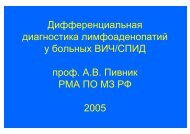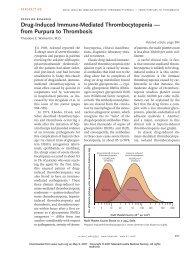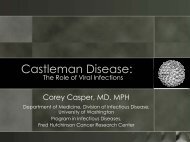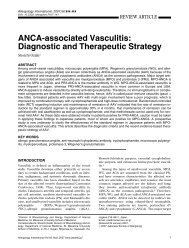Cladribine combined with cyclophosphamide and ... - Hem-aids.ru
Cladribine combined with cyclophosphamide and ... - Hem-aids.ru
Cladribine combined with cyclophosphamide and ... - Hem-aids.ru
Create successful ePaper yourself
Turn your PDF publications into a flip-book with our unique Google optimized e-Paper software.
1512<br />
CMC in untreated CLL<br />
T Robak et al<br />
concentration 11.0 g/dl, platelet count 100 × 10 9 /l <strong>and</strong><br />
bone marrow <strong>with</strong> less than 30% lymphocytes for at least 2<br />
months. Partial response (PR) was considered in the case of a<br />
50% or greater decrease in the size of lymph nodes, liver <strong>and</strong><br />
spleen, <strong>and</strong> peripheral blood findings either identical to those<br />
of CR or improved over pre-therapy values by at least 50%.<br />
The patients who had not achieved CR or PR were classified<br />
as non-responders (NR). Clinical relapse was defined accordingto<br />
Robertson et al 9 as an increase in the absolute lymphocyte<br />
count above 10 × 10 9 /l, more than 50% increase in the<br />
sum of the size of at least two lymph nodes, appearance of<br />
new lymph nodes, more than a 50% increase in the liver or<br />
spleen below the costal margin, the new appearance of palpable<br />
hepatosplenomegaly or development of an aggressive<br />
lymphoma.<br />
Immunophenotype analysis<br />
Immunophenotypingwas performed on peripheral blood <strong>and</strong><br />
bone marrow by flow cytometry usinga simultaneous dualcolor<br />
stainingtechnique before treatment <strong>and</strong> after obtaining<br />
CR, accordingto the method described by B<strong>ru</strong>giatelli et al. 26 A<br />
combination of phycoerythrin (PE)-conjugated <strong>and</strong> fluorescent<br />
isothiocyanate (FITC)-conjugated monoclonal antibodies was<br />
utilized. Residual disease was determined by co-expression of<br />
CD5/CD19 <strong>and</strong> CD5/CD20 on B lymphocytes in conjunction<br />
<strong>with</strong> monoclonality of surface light-chain expression on CD5-<br />
positive B cells. The presence of more than 10% of the total<br />
lymphocytic population co-expressingCD5/CD19 <strong>and</strong><br />
CD5/CD20 <strong>with</strong> monotypic light-chain expression (a : or<br />
: ratio exceeding3:1) was considered positive for residual<br />
disease, accordingto the criteria developed by Robertson et<br />
al. 9<br />
Toxicity monitoring<br />
<strong>Hem</strong>atological toxicity was evaluated according to the criteria<br />
developed by the NCI-Sponsored WorkingGroup. 22 D<strong>ru</strong>ginduced<br />
anemia, thrombocytopenia <strong>and</strong> neutropenia were<br />
diagnosed if after the treatment course a further decrease of<br />
hemoglobin level <strong>and</strong>/or platelets <strong>and</strong> neutrophils numbers<br />
were observed. Other side-effects were assessed <strong>and</strong> monitored<br />
accordingto WHO criteria. 27<br />
Only major <strong>and</strong> moderate infections were recorded, includinglife-threateningepisodes<br />
such as pneumonia <strong>and</strong> disseminated<br />
infections that required oral or parenteral antibiotic<br />
therapy, antifungal <strong>and</strong> antiviral therapy <strong>and</strong>/or hospitalization.<br />
Fever of unknown origin (FUO) requiring parenteral<br />
antibiotic therapy was also recorded as an infectious event.<br />
Infections were reported as CMC related if they developed on<br />
therapy or <strong>with</strong>in 4 months of the completion of the CMC<br />
treatment.<br />
Statistical analysis<br />
Statistical analysis of the differences in the percentages of<br />
responses in patients treated <strong>with</strong> CMC3 <strong>and</strong> CMC5 were<br />
evaluated by the 2 test. Ninety-five percent confidence intervals<br />
for response probability were calculated usingthe<br />
method described by Duffy <strong>and</strong> Santner. 28<br />
Results<br />
Sixty-two patients <strong>with</strong> B-CLL entered the study <strong>and</strong> all of<br />
them were analyzed. The median time from the diagnosis to<br />
CMC administration was 8.2 months (range 4–26). The<br />
characteristics of the patients are presented in Table 1. Twenty<br />
patients were treated accordingto CMC5 protocol <strong>and</strong> 42<br />
received CMC3 chemotherapy. The total number of CMC<br />
courses administered to the entire group of patients amounted<br />
to 237 (84 CMC5 <strong>and</strong> 153 CMC3 courses). The median number<br />
of CMC3 courses was 3.8 (range 1–6), <strong>and</strong> the median<br />
time needed to deliver the total number of cycles was 4.6<br />
months (range 1–8.7). The patients treated <strong>with</strong> CMC5<br />
received from 1 to 6 (median 2.5) courses, <strong>and</strong> the median<br />
time needed to deliver the total number of cycles was 5.7<br />
months (range 1–10.2). In the CMC3 group 8 (19%) patients,<br />
<strong>and</strong> in the CMC5 group 9 (45%) patients, could not reach the<br />
total of three cycles because of early death or severe myelotoxicity.<br />
The criteria for CR were fulfilled in 18 patients (29.0%) <strong>and</strong><br />
PR in 22 (35.5%), giving an overall response rate in 64.5%<br />
(95% CI 52.7–76.3%) of total patients (Table 2). There were<br />
no differences in the frequency of OR between the CMC5-<br />
<strong>and</strong> the CMC3-treated groups (55% <strong>and</strong> 69%, respectively, P<br />
= 0.3). The CR rate was also similar in both groups (30% <strong>and</strong><br />
28.6%, respectively) (P = 0.9). In the group treated <strong>with</strong> CMC5<br />
the patients attainingCR received a median of three courses<br />
(range 2–6) <strong>and</strong> in the group treated <strong>with</strong> CMC3 a median of<br />
three courses (range 2–6) was also administered. CRs were<br />
observed more frequently in the early stages of the disease<br />
(Rai 0, I <strong>and</strong> II) – 11/29 (37.9%) than in the more advanced<br />
stages (Rai III <strong>and</strong> IV) – 7/33 (21.2%) (P = 0.8).<br />
Surface immunophenotypingby flow cytometry usingdualcolor<br />
stainingon peripheral blood <strong>and</strong>/or bone marrow was<br />
performed in patients who achieved CR. Residual disease was<br />
identified in seven out of 18 (38.9%) patients who achieved<br />
remission.<br />
Toxicity<br />
Myelosuppression was the major toxicity of the CMC therapy<br />
(Table 3). Grades III <strong>and</strong> IV neutropenia were observed in 18<br />
(29.0%) out of 62 patients <strong>and</strong> after 30 (12.7%) out of 237<br />
CMC courses. There was no significant difference between the<br />
frequency of severe neutropenia in the 7/20 (35%) patients<br />
treated <strong>with</strong> CMC5 or 11/42 (26.2%) patients treated <strong>with</strong><br />
CMC3 regimens (P = 0.8). <strong>Hem</strong>atopoietic growth factors (G-<br />
CSF or GM-CSF) were administered after four <strong>and</strong> 13<br />
courses, respectively.<br />
The frequency of thrombocytopenia was similar (20% <strong>and</strong><br />
19%) in both groups (P = 0.8). Grade III or IV anemia was the<br />
rarest hematological complication <strong>and</strong> was observed in only<br />
four patients. Autoimmune hemolytic anemia (AIHA)<br />
developed in two patients treated <strong>with</strong> CMC3. These patients<br />
had no clinical or laboratory symptoms of this complication<br />
before CMC treatment.<br />
Severe infections <strong>and</strong> fever of unknown origin (FUO) requiringparenteral<br />
antibiotic therapy occurred more often in<br />
patients treated <strong>with</strong> the CMC5 regimen – 11 patients (55%)<br />
than CMC3 – 10 patients (23.8%) (P = 0.03). The number of<br />
severe infections <strong>and</strong> FUO was also more frequent after CMC5<br />
courses – 15 (17.9%) than CMC3 courses – 12 (7.8%) (P =<br />
0.03). Pneumonia <strong>and</strong> upper respiratory infections (sinusitis<br />
<strong>and</strong> bronchitis) occurred in 23 patients, including12 treated<br />
Leukemia







